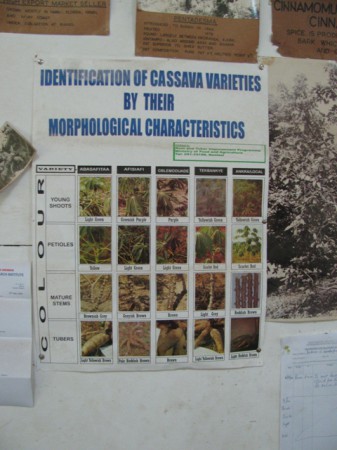 Call me old-fashioned, but I have a soft spot for this kind of poster. This particular example was at CSIR’s Plant Genetic Resources Institute, Bunso, Ghana. Beats an SSR dendrogram thingie any time.
Call me old-fashioned, but I have a soft spot for this kind of poster. This particular example was at CSIR’s Plant Genetic Resources Institute, Bunso, Ghana. Beats an SSR dendrogram thingie any time.
Nibbles: Small farmers, Wild bananas, Titan arum, Fish for diversity, Tenure, Treaty, Australian genebank, Mexican genebank, Mexican drought, Potato record, Khat and fodder in Ethiopia
- On my signal, unleash the potential of small farmers and food producers worldwide. Has a return ring to it.
- More than anyone could reasonably want to know about wild banana relatives in Thailand.
- Big stinky flower with its own webcam. Must be a wild relative of something.
- Better in many ways to catch a diversity of fish species than to focus on one.
- Could probably do with some guidelines for access to fisheries, though, right?
- International Seed Treaty secretariat knocks ‘em dead down under. “THREE-quarters of the world’s crop biodiversity has been irrevocably lost since 1900.”
- Of course it has. Did Dr Bhatti visit this place during his tour of Oz, I wonder? If not, maybe he’ll visit Mexico next and see this place. And speaking of Mexico…
- Mexico sneezes, US grain exports catch a cold?
- World record potato harvest in Bihar; there’s a lot that’s fishy about this story.
- “Khat cultivation in Ethiopia fuels economy, reduces deforestation.” And makes people sick, but who’s counting.
- Ah but here’s a possible alternative. Now, if only CIFOR and ILRI would talk together about this.
Nibbles: Treaty in Malaysia, Vavilov in Sardinia, Vegetative crops, Aquaculture, Indian AnGR, Seed Savers, Ancient Egypt and thereabouts, Quinoa in Chile
- Michael Halewood in Genebank Policy Hell.
- Vavilov in Genebank Database Hell.
- A guide through Clonal Crops Conservation Hell.
- Pakistan contemplates genebank for carp “pure line and improved stairs for SAARC countries.” Bicycles next, I suppose. But will Ghana follow suit?
- Meanwhile across the border, India is putting resources into livestock conservation at both national and state level.
- Italian broccoli variety moves to Florida and makes the big time.
- And ancient Egyptian gardens make the big time in Amsterdam. Too bad it wont be possible to exchange seeds.
- I bet those ancient Egyptians had taro. They certainly had wheat and barley.
- But not quinoa, alas, despite what Thor Heyerdahl might have thought.
Nibbles: Communications, Economics, Nutrition, Conservation
- What words should we use? “[B]est management practices” or “more casual words like local, family-owned and farmer”.
- Words like “farming”. How to make a living “farming” without leaving your armchair. Via.
- Hungry work, that. If only I had a slice of acorn-finished pork to finish.
- Someone else who would like that: where in the world is Luigi Guarino? Wherever “it is imperative that genetic diversity is maintained for posterity.”
Brainfood: Beans, Potatoes, Lettuce, Agave, Gaming, Mangroves, Ancient millets, Ancient missions
- Mesoamerican origin of the common bean (Phaseolus vulgaris L.) is revealed by sequence data. Revealed is kinda strong isn’t it? This from a bean expert of my acquaintance: “Yes, we knew that, as it seems to be the case of all species of the Phaseoli section. They could have done a bit better in including the 2 populations of Cordoba mountain, in order to see whether these belong to the first migration to the Andes, or the second one. Wild vulgaris from western Panama, or Venezuela, could have helped in this regard too. We have shown years ago that the complex genetic structure in Mexico and in Colombia is the result of these floristic migrations combined with gene flow events because beans cross among themselves.”
- The Enigma of Solanum maglia in the Origin of the Chilean Cultivated Potato, Solanum tuberosum Chilotanum Group. These are long-day adapted and therefore crucial to the history of the potato in Europe. But the various sorts of evidence looked at to investigate their relationship to the rare Chilean wild relative S. maglia just do not agree. Bummer.
- Wild and weedy Lactuca species, their distribution, ecogeography and ecobiology in USA and Canada. So Iowa is a wild lettuce hotspot. If you’re interested in the germplasm, it’ll be in the genebank of Palacký University in the Czech Republic.
- Sustainability of the traditional management of Agave genetic resources in the elaboration of mezcal and tequila spirits in western Mexico. Tequila industrial agriculture should learn from the traditional kind.
- Fate of the World: computer gaming for conservation. Worth a try. No, really.
- The Economic Value of Mangroves: A Meta-Analysis. You might think there would be a value in the abstract; you would be wrong.
- Early millet use in northern China. That would be Setaria italica and Panicum miliaceum, and new evidence from ancient starch grain on pottery and grinding stones found in archaeological sites has pushed back their cultivation in N China by 1000 and 2000 years respectively, to about 9500-7500 BC. The Archaeobotanist has more, as ever.
- Digitization and online availability of original collecting mission data to improve data quality and enhance the conservation and use of plant genetic resources. They’re there (and here; what’s up with that?) to consult and make use of if you want.
And don’t forget, you can join our group on Mendeley, subscribe to the feed, and have all this filtered goodness delivered to the RSS reader of your choice.